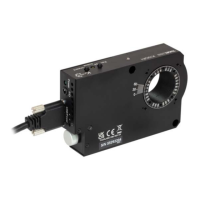47
K10CR1 Cage Rotation Stage
Right/Bottom Button Pos.: The position to which the motor will move when the
‘Forward’ button is pressed.
Triggering
The unit is fitted with a 3.5 mm 4-way jack I/O connector that allows the connection of
external TTL compatible signals to initiate moves (Trigger In) and generate a
hardware signal when certain motion related conditions are met (Trigger Out). It is
possible to configure a particular controller to respond to trigger inputs, generate
trigger outputs or both simultaneously. For those units configured for both input and
output triggering, a move can be initiated via a trigger input while at the same time, a
trigger output can be generated to initiate a move on another unit.
The trigger settings can be used to configure multiple units in a master – slave set up,
thereby allowing multiple channels of motion to be synchronized. Multiple moves can
then be initiated via a single software or hardware trigger command.
Trig In
The Trigger In input can be configured to initiate a relative, absolute or homing home,
either on the rising or falling edge of the signal driving it. As the trigger input is edge
sensitive, it needs to see a logic LOW to HIGH transition ("rising edge") or a logic
HIGH to LOW transition ("falling edge") for the move to be started. Additionally, the
move parameters must be downloaded to the unit prior to the move using the relevent
relative move or absolute move software methods as described following. A move
already in progress will not be interrupted; therefore external triggering will not work
until the previous move has been completed.
In order to avoid unexpected moves being executed on start-up, the trigger input
settings cannot be persisted and will default to the input being disabled on power-up.
Even when input triggering is disabled, the state of the Trigger In input can be read at
any time by using the LLGetStatusBits software method to read the status register bit
1. This allows application software to use the Trigger In input as a general-purpose
digital input - see the APTServer helpfile for details on using the LLGetStatusBits
method and the status register.
Trigger In options are set as follows:
Disabled – triggering operation is disabled
Rel Move (Trig Rise) – a relative move (specified using the latest MoveRelative or
MoveRelativeEx method settings) is initiated on the specified channel when a rising
edge input signal is received on the TRIG IN connector.
Rel Move (Trig Fall) – as above, but the relative move is initiated on receipt of a falling
edge signal.
Note
A ‘Home’ move can be performed by pressing and holding both buttons
for 2 seconds. This function is irrespective of the ‘Button Mode’ setting.

